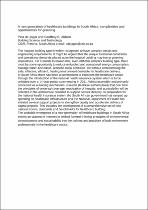 ResearchSpace
ResearchSpace
A new generation of healthcare buildings in South Africa: complexities and opportunities for greening
JavaScript is disabled for your browser. Some features of this site may not work without it.
- ResearchSpace
- →
- Research Publications/Outputs
- →
- Conference Publications
- →
- View Item
| dc.contributor.author |
De Jager, Peta

|
|
| dc.contributor.author |
Abbott, GR

|
|
| dc.date.accessioned | 2013-11-13T06:34:14Z | |
| dc.date.available | 2013-11-13T06:34:14Z | |
| dc.date.issued | 2012-07 | |
| dc.identifier.citation | De Jager, P and Abbott, GR. 2012. A new generation of healthcare buildings in South Africa: complexities and opportunities for greening. In: Green Building Conference and Exhibition: Future Trends and Issues Impacting on the Built Environment, Sandton, South Africa, 25-26 July 2012 | en_US |
| dc.identifier.uri | http://hdl.handle.net/10204/7059 | |
| dc.description | Green Building Conference and Exhibition: Future Trends and Issues Impacting on the Built Environment, Sandton, South Africa, 25-26 July 2012 | en_US |
| dc.description.abstract | The hospital building type is widely recognised to have complex design and engineering requirements. It might be argued that the unique functional constraints and operational demands placed upon the hospital building may trump greening imperatives. Yet it stands to reason that, even with this complex building type, there must be some opportunity to reduce embodied and operational energy consumption, manage water and waste, promote social cohesion, etc without compromising the safe, effective, efficient, healing environment desirable for healthcare delivery. In South Africa there has been a commitment to transform the healthcare sector through the introduction of the national health insurance system which is to be unfolded over a 14 year period commencing in 2011. Whilst ostensibly and primarily conceived as a funding mechanism, it seems (to these authors) likely that over time the principles of universal coverage, eradication of inequity, and accessibility will be reflected in the architecture provided to support service delivery. In preparation for the national health insurance system the South African government has ramped up spending on healthcare infrastructure and the National Department of Health has initiated several support projects to strengthen quality and accelerate delivery of capital projects. This includes the development of a comprehensive set of new national norms, standards and benchmarks for healthcare building. The probable emergence of a new generation of healthcare buildings in South Africa seems an opportune moment to embed forward-thinking principles of environmental consciousness and sustainability into the policies and practices of built environment professionals in the healthcare sector. | en_US |
| dc.language.iso | en | en_US |
| dc.relation.ispartofseries | Workflow request;10183 | |
| dc.subject | South African healthcare buildings | en_US |
| dc.subject | Hospital building types | en_US |
| dc.subject | National health insurance systems | en_US |
| dc.subject | Green healthcare buildings | en_US |
| dc.title | A new generation of healthcare buildings in South Africa: complexities and opportunities for greening | en_US |
| dc.type | Conference Presentation | en_US |
| dc.identifier.apacitation | De Jager, P., & Abbott, G. (2012). A new generation of healthcare buildings in South Africa: complexities and opportunities for greening. http://hdl.handle.net/10204/7059 | en_ZA |
| dc.identifier.chicagocitation | De Jager, Peta, and GR Abbott. "A new generation of healthcare buildings in South Africa: complexities and opportunities for greening." (2012): http://hdl.handle.net/10204/7059 | en_ZA |
| dc.identifier.vancouvercitation | De Jager P, Abbott G, A new generation of healthcare buildings in South Africa: complexities and opportunities for greening; 2012. http://hdl.handle.net/10204/7059 . | en_ZA |
| dc.identifier.ris | TY - Conference Presentation AU - De Jager, Peta AU - Abbott, GR AB - The hospital building type is widely recognised to have complex design and engineering requirements. It might be argued that the unique functional constraints and operational demands placed upon the hospital building may trump greening imperatives. Yet it stands to reason that, even with this complex building type, there must be some opportunity to reduce embodied and operational energy consumption, manage water and waste, promote social cohesion, etc without compromising the safe, effective, efficient, healing environment desirable for healthcare delivery. In South Africa there has been a commitment to transform the healthcare sector through the introduction of the national health insurance system which is to be unfolded over a 14 year period commencing in 2011. Whilst ostensibly and primarily conceived as a funding mechanism, it seems (to these authors) likely that over time the principles of universal coverage, eradication of inequity, and accessibility will be reflected in the architecture provided to support service delivery. In preparation for the national health insurance system the South African government has ramped up spending on healthcare infrastructure and the National Department of Health has initiated several support projects to strengthen quality and accelerate delivery of capital projects. This includes the development of a comprehensive set of new national norms, standards and benchmarks for healthcare building. The probable emergence of a new generation of healthcare buildings in South Africa seems an opportune moment to embed forward-thinking principles of environmental consciousness and sustainability into the policies and practices of built environment professionals in the healthcare sector. DA - 2012-07 DB - ResearchSpace DP - CSIR KW - South African healthcare buildings KW - Hospital building types KW - National health insurance systems KW - Green healthcare buildings LK - https://researchspace.csir.co.za PY - 2012 T1 - A new generation of healthcare buildings in South Africa: complexities and opportunities for greening TI - A new generation of healthcare buildings in South Africa: complexities and opportunities for greening UR - http://hdl.handle.net/10204/7059 ER - | en_ZA |





